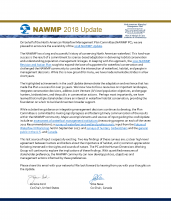
On behalf of the North American Waterfowl Management Plan Committee (NAWMP PC), we are pleased to announce the availability of the 2018 NAWMP Update.
The NAWMP has a long and successful history of conserving North American waterfowl. This hard-won success is the result of a commitment to science-based adaptation in delivering habitat conservation and understanding population-management linkages. In keeping with this approach, the 2012 NAWMP Revision and Action Plan sought to expand the base of supporters for waterfowl conservation and challenged the NAWMP community to consider the intersection of waterfowl, habitat, and people in management decisions. While this is new ground for many, we have made remarkable strides in a few short years.
The highlighted achievements in the 2018 Update demonstrate the adaptation and resilience that has made the Plan a success for over 30 years. We know how to focus resources on important landscapes, integrate conservation decisions, address Joint Venture (JV)-level population objectives, and engage hunters, birdwatchers, and the public in conservation actions. Perhaps most importantly, we have learned that multiple stakeholders share an interest in waterfowl habitat conservation, providing the foundation on which to build and maintain broader support.
While substantive guidance on integrating management decisions continues to develop, the Plan Committee is committed to making rapid progress and fostering timely communication of the results within the NAWMP community. Major accomplishments and sources of input guiding the 2018 Update include an assessment of waterfowl management institutions (measuring progress on each of the seven 2012 Recommendations); a survey of waterfowl and wetland professionals; input from the Future of Waterfowl II Workshop held in September 2017; and surveys of hunters, birdwatchers and the general public in the U.S. and Canada.
This last source of input is especially exciting. Two key findings of these surveys are: 1) clear high-level agreement between hunters and birders about the importance of habitat, and 2) common appreciation for being immersed in the sights and sounds of nature. The PC and the Human Dimensions Working Group will continue to explore the implications of these findings. With quantified measures of stakeholder preference, the NAWMP community can now develop policies, objectives and management actions informed by these preferences.
Please share this email with your networks! We look forward to hearing from you with your thoughts on the Update.
Jerome Ford Silke Neve
Co-Chair, United States Co-Chair, Canada
